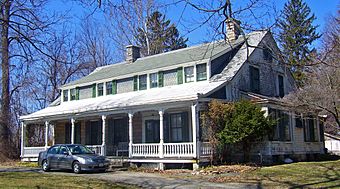General John Hathorn Stone House facts for kids
Quick facts for kids |
|
|
Gen. John Hathorn Stone House
|
|

Front elevation and east profile in 2008
|
|
| Location | Warwick, NY |
|---|---|
| Nearest city | Middletown |
| Area | 14 acres (5.6 ha) |
| Built | 1773 |
| Architect | John Hathorn |
| NRHP reference No. | 01000252 |
| Added to NRHP | 2001 |
The General John Hathorn Stone House is a historic home located in Warwick, New York. It was built by John Hathorn in 1773. Over time, the house was made much bigger in the mid-1800s.
The house sits on a 14-acre (5.6-hectare) piece of land. This land is what's left of the original 300 acres (120 hectares) that Hathorn and his family used for farming. In 2001, the house and another old building from the early 1800s were added to the National Register of Historic Places. This means they are important historical sites.
Contents
About the Hathorn Stone House
What the House Looks Like
The house has six sections and is one-and-a-half stories tall. It is built from strong stone. Some parts use rough, uneven stones, while others use smoother, cut stones. The roof is made of asphalt shingles. A wooden porch stretches across the front of the house. Its roof continues the line of the main roof. Small dormer windows stick out from the second story. Two wooden sections extend from the back and side of the house.
On the west side of the house, large letters made of brick spell out "E., I & H, 1773". This refers to John Hathorn, his wife Elizabeth, and the year the house was built. Inside, many rooms still have furniture and decorations from the Victorian era. This was when the house was greatly updated. Behind the main house, there's another building from the mid-1800s. It was built in the Greek Revival style and has been used for different things over the years.
History of General John Hathorn
Early Life and Building the House
John Hathorn was born in what is now Delaware. When he was young, he helped survey the land. This means he helped map out the border between New York and New Jersey. This border had been a source of arguments for many years.
Hathorn settled in Warwick and opened a store and an iron forge in 1770. He built the stone house in 1773 after marrying Elizabeth Welling. The tradition of putting initials and the building year into the side of a house was common for German settlers. This shows how much German traditions influenced building styles in the Hudson Valley.
Hathorn's Role in the American Revolution
During the Revolutionary War, John Hathorn became a military leader. He started as a captain and rose to the rank of colonel. After the war, he was promoted to major general. People say that George Washington himself stayed at Hathorn's house twice.
Hathorn led the local militia, which was a group of citizen soldiers. Their job was to protect the Ramapo area, which was an important way into the Hudson Valley. Hathorn was one of the few who survived a battle against Joseph Brant at the Battle of Minisink Ford. The front of his house even has a small hidden spot, called a niche. It's said he hid there for a week to escape from local Loyalists and their Native American allies who wanted to harm him.
After the War and Later Owners
After the war, Hathorn had a successful career in politics. He served in the New York State Assembly, where he became the speaker. He also served in the state senate and later in the U.S. House of Representatives in the early 1800s.
John Hathorn passed away in 1825. His family owned the house for nine more years. Then, they sold it to the Sanford family. The Sanfords added the building in the back, the side sections, and the porch. They also made the house twice its original size. In 1923, the Sanfords sold the house to another family. Since then, it has had several different owners. Hathorn's descendants have even held family reunions at the house in 1923 and again in 2000.
Today, the road where the house is located is named Hathorn Road, honoring John Hathorn. There is also a nearby restaurant called Chateau Hathorn.
Hathorn Farm and Education
Since 2009, the land across the street from the Hathorn Stone House has been used for a special farming and education project called Hathorn Farm. This farm uses Permaculture practices. Permaculture is a way of designing farms and gardens that works with nature, like using rainwater wisely and growing only natural, healthy produce.
Hathorn Farm also offers courses to teach people about Permaculture Design. The owners of the farm want to bring back old farming methods and educate people about homesteading. They believe many of these natural ways of living were common in the past.

